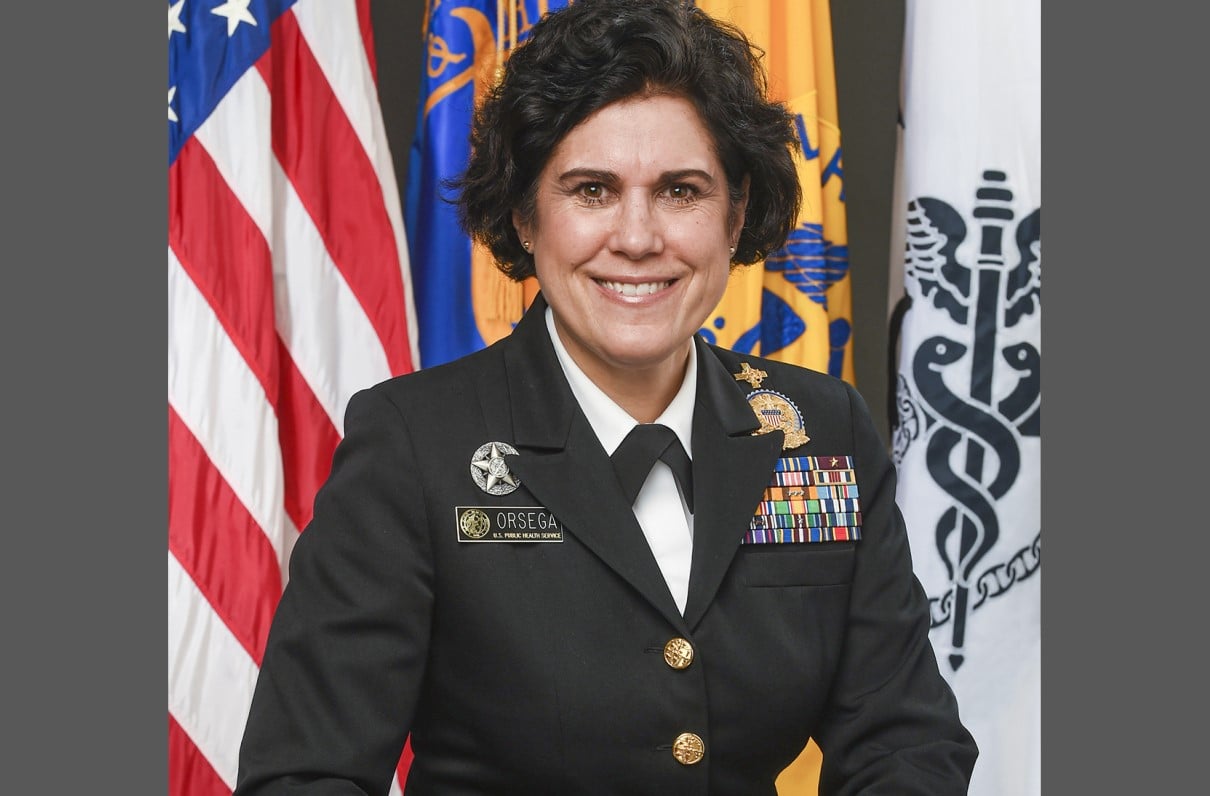(This article originally appeared in the January 2022 issue of Military Officer, a magazine available to all MOAA Premium and Life members. Learn more about the magazine here; learn more about joining MOAA here.)
Rear Adm. Susan Orsega began her career in the USPHS Commissioned Corps in 1989 at the National Institutes of Health during the HIV/AIDS epidemic. Thirty years later, she had ascended to Commissioned Corps headquarters director.
During the COVID-19 pandemic, Orsega was responsible for directing all functions regarding personnel, administration, operations, readiness, deployment, and policy for the USPHS Commissioned Corps. She was the principal advisor to the surgeon general on activities and policies related to Commissioned Corps training, preparedness, activation, deployment, and total force fitness.
Before taking on a new role as senior advisor to the assistant secretary for health and surgeon general, Orsega talked to Military Officer about the future of the Commissioned Corps. The following interview has been edited for length and clarity.
[FOR PREMIUM AND LIFE MEMBERS: Expanded Military Officer Digital Archives]
Q. What is your vision for the Commissioned Corps in the coming years?
A. Certainly today, [with COVID-19] exceeding the number of cases from the 1918 [flu] pandemic, there’s a real call to action for the Corps to be able to respond to public health crises. My vision is to have a cadre of officers who are nimble enough to provide that essential public health leadership service, both in their day-to-day jobs, as well as being on the front lines for the increased demands that are occurring across the nation [and] in the world.
Q. Public Health Service officers have recently embarked on a record number of deployments. What are the most pressing missions they are focusing on right now?
A. Commissioned Corps deployments have increased significantly. … For [nearly two years], our focus has been on the front lines supporting states for COVID-19. The Commissioned Corps will be filling those essential public health leadership roles. … For example, they are on the front lines of clinical practice at the Indian Health Service, regulation and policy development at the Food and Drug Administration, and epidemiology and science, both at the Centers for Disease Control and Prevention as well as the National Institutes of Health. We’ve been in this historic battle for 21 months. That backdrop of service, commitment, leadership, and excellence is [driving] the Corps to move forward.
Because of the deployments, operational tempo has increased. With the CARES Act in 2020, we had the opportunity with a legislative fix for the Public Health Service Ready Reserve. That allowed us to expand the number of officers who are side by side with the active component — part-time officers who then get called up and lined up with our other uniformed services.
[RELATED: MOAA Interviews Gen. Charles Q. Brown Jr., Air Force Chief of Staff]
The National Guard Bureau helped us think through our key policies as a result of the established Memorandum of Agreement. We are excited to have that profound positive impact on our public health capability that ensures the Commissioned Corps has resources to respond to regional, national, and global public health emergencies.
In September [2020], we opened applications for the Ready Reserve. We are now bringing on our Ready Reservists, and [we] had our first officer basic course in July. It’s really exciting. … The Ready Reserve provides us that sufficient supply of health care professionals that can deploy and leverage specialty skill sets that may be impractical in an active duty, full-time capacity.
We also have the public health emergency response strike team also afforded through COVID-19 supplemental funding. The public health emergency response strike team is comprised of a small select cadre of public health full-time active-duty officers. They deploy immediately within about eight hours of that request from the president or the secretary.
Q. As more folks get vaccinated, how has the Corps’ response to the pandemic shifted?
A. [In 2020], we were deployed to support COVID-19 testing and supportive care. In 2021, it was vaccinations and monoclonal antibody treatments. The Corps continues to be agile and nimble. That’s our battle cry. … We’re also leveraging the officers supporting and deploying to augment the [Centers for Disease Control and Prevention]. It has required ... making sure our officers’ capacity matches up with the requirements. It’s been tough. This is a long, long mission for Public Health Service officers. … Certainly, our officers continue to serve in the efforts around vaccinations.
[RELATED: Watch MOAA’s Interview With Col. Shane Kimbrough, USA (Ret), From Orbit]
Q. The Public Health Service recently adopted the DD-214 form. Why was that decision made?
A. We needed to align ourselves with the other services in terms of the paperwork we had. But as you can imagine, every technical fix requires a lot of conversations and IT system changes. … With DoD’s Manpower Data Center, we were able to work collaboratively … and make this a reality. The Ready Reserve was another reason to [do this]. The more that the Public Health Service aligns our thinking and who we are — in terms of our capabilities, capacities, and our policies — to the other services, the better we will be in the future. … It’s important for us to make sure we all are looking at each other as uniformed service officers.
Q. Do you have any closing thoughts?
A. We’re at that intersection where we have the opportunity to [determine where to] take the Corps in the next 200 years. The Ready Reserve, the public health emergency response strike team, and even the DD-214 are all steps along the way of building the Corps as a strong public health leader … and being that backstop for those states, cities, and local jurisdictions that need a Public Health Service. It’s an exciting time for the Corps.
Military Officer Magazine
Check out our award-winning monthly magazine. MOAA PREMIUM and LIFE members have access to all editions here.

